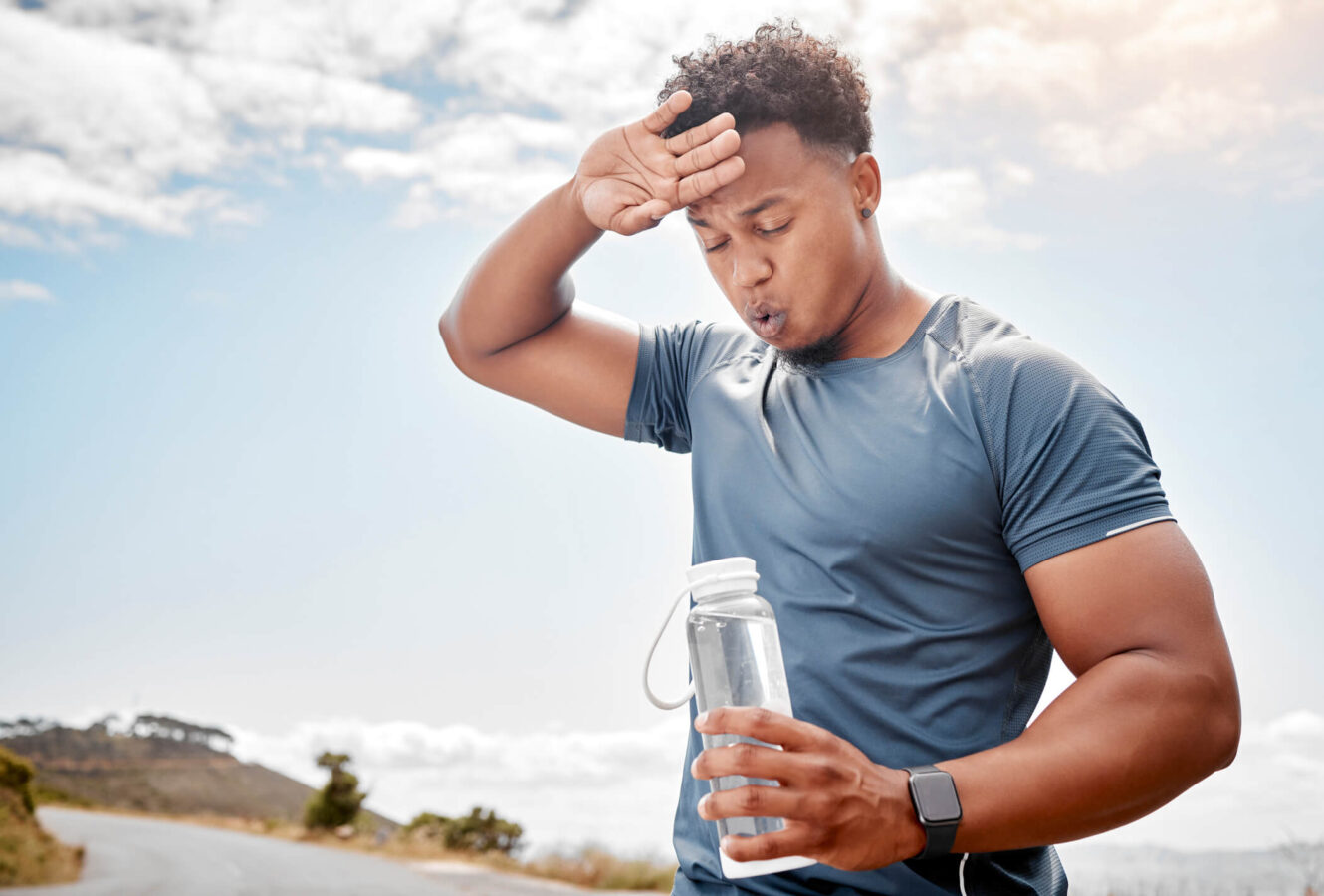
Medically reviewed by Domonique Martin
When the weather is hot and humid, it is harder for the body to cool itself. If your body heat rises too rapidly, or you lose too much salt and fluid from sweating or dehydration, you can experience a heat-related illness. Left untreated, extreme heat can cause serious health complications. Learn more about sports physical therapy treatment options. Keep reading to understand the signs of heat illness and hydration tips to prevent heat-related sports injuries.
Extreme heat is defined as temperatures of 90 degrees F or higher lasting two to three days or more. The human body must work overtime to maintain a normal temperature in these conditions. If the body cannot cool itself, it produces and retains more heat than it dissipates. This is overheating. Overheating and dehydration can lead to heat-related illnesses.
Individuals who exercise in extreme heat are at high risk of heat-related injuries because intense physical activity generates excess body heat that is hard to release. For someone who exerts themselves in hot, humid weather without sufficient hydration, sweating may not be adequate to cool the body to a safe level. Fortunately, summer-heat related sports injuries are preventable using the tips below.
Heat-related illness (hyperthermia) refers to several conditions that occur when the body struggles to cool itself down. These conditions range from mild to serious and potentially life-threatening. Here are the four most common types of heat illness, from least to most severe.
Heat rash involves clusters of tiny bumps caused by sweat trapped under the skin. These bumps commonly appear on the upper chest, neck, and within skin folds. They may feel prickly or itchy.
Also known as exercise-associated muscle cramps, heat cramps occur with intense physical exertion and excessive sweating in the heat. The arms, legs, and belly are often affected. These muscle cramps and spasms are a warning sign that more serious heat illness is possible without rest and cooling.
This is a moderate type of heat illness caused by exertion in high heat when too much salt and/or water is lost. Symptoms of heat exhaustion include headache, dizziness, nausea, and vomiting. You may have heat exhaustion if your body’s internal temperature is high but below 104 degrees F.
Heat stroke is a life-threatening condition and a medical emergency. It occurs when the body’s internal temperature is extremely high (generally 104 degrees F or above). Symptoms of heat stroke can include intense, throbbing headache, dizziness, confusion, nausea, dry or damp skin, and a rapid and strong pulse.
In some cases, fainting and loss of consciousness are possible. Someone exhibiting signs of heat stroke should be moved to a cooler environment, and cool, damp towels should be applied. Call 911 or transport the victim to the hospital as quickly as possible. Heat stroke can result in shock, organ failure, brain damage, and death.
You don’t have to spend your summer indoors or take a break from the sport you love if you take steps to stay safe and hydrated. Here are the most simple and effective ways to prevent hyperthermia.
It is equally important to stay alert and know the early signs of heat illness to act quickly, cool the body down, and prevent serious complications.
Everyone should stay vigilant for early signs of hyperthermia when exercising or playing sports in hot, humid weather.
Possible symptoms of heat illness include:
Stop exercising or playing sports immediately at the first sign of heat-related illness and move to a cool, shaded area. Drink cool water or an electrolyte beverage. If you have heat cramps, gently stretch the affected muscles. If you suspect heat exhaustion, contact 911 immediately for emergency assistance.
Whether you are a highly competitive athlete or a weekend warrior, knowing how to stay hydrated during summer sports to prevent heat related sports injuries is essential. Proper hydration is more than drinking extra water before a big game. It’s about consuming enough fluids daily to feel and function your best.
Nearly half of Americans aren’t drinking enough water. This is especially problematic for people who play sports in the heat because they sweat more and raise their body temperature. Staying hydrated helps the body temperature return to normal range, and it’s essential to replace lost fluids during intense physical activity.
The Mayo Clinic recommends around 15.5 cups of fluids daily for men and 11.5 cups for women—with an important caveat. In hot, humid weather, more water is needed to prevent hydration. The same is true if you work out, play sports, or do any activities that make you sweat. To gauge your hydration, check the color of your urine. If it’s pale yellow to clear, you are well-hydrated.
Waiting until you start playing sports is too late to hydrate, especially if you haven’t been drinking enough fluids in the hours and days prior. To avoid dehydration, drink water with each meal and between meals, before, during, and after exercise, and whenever you feel thirsty.
Physical therapy plays a valuable role in preventing and treating heat-related sports injuries. Athletes working with physical therapists learn to acclimate gradually and safely to heat and humidity.
Therapists provide exercises and stretching programs to warm up and cool down before and after physical activity. Massage and other manual therapies can relieve and release short, tense tissues for athletes with painful heat cramps.
Education may be the most powerful tool physical therapy offers for preventing heat illness during hot-weather sports. Physical therapists, including trainers and sports therapists, teach players how to hydrate effectively and reduce exposure to sun, heat, and humidity. They share the signs of heat illness to help athletes stay safe and healthy when the temperature rises.
To improve your performance and overcome common sports-related injuries, schedule a physical therapy screening at a clinic near you.